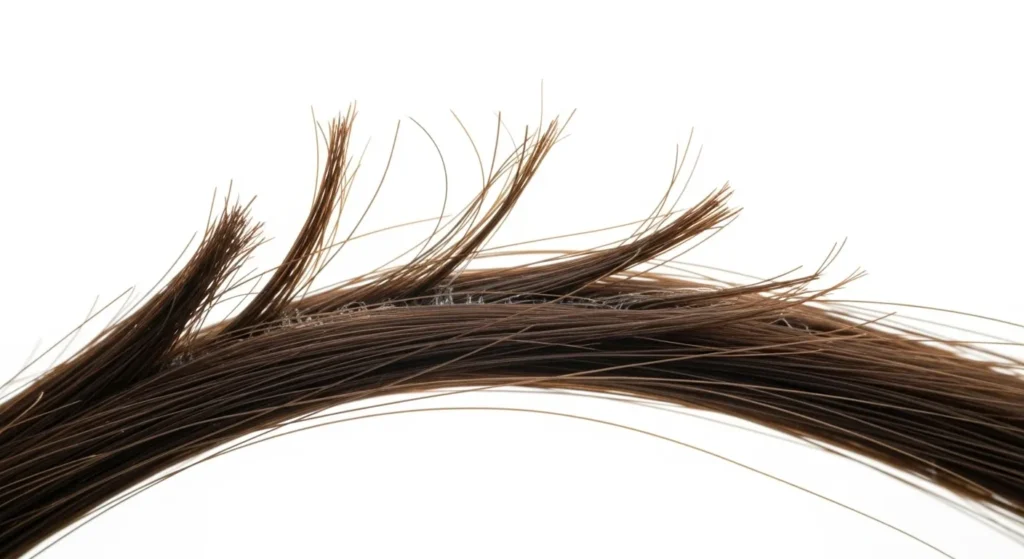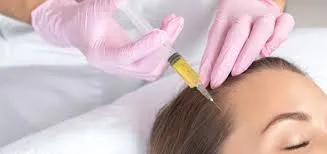If you’re dealing with dry, frayed hair and notice more strands on your brush than usual, you might be wondering: do split ends cause hair loss?
While split ends don’t directly lead to hair falling from the scalp, they can cause breakage that affects the overall appearance and volume of your hair.
In this article, we’ll clarify the difference between split ends and actual hair loss, explore how they relate, and offer expert-backed tips to restore healthy hair. Let’s separate myth from reality with facts you can trust.
What Are Split Ends?

Split ends are a common form of hair shaft damage that can make your hair look frizzy, thin, and unhealthy.
Definition and Types of Split Ends
Split ends occur when the protective outer layer of your hair—the cuticle—wears away due to damage, causing the hair strand to split at the end. Types of split ends include:
- Classic split: One hair splits into two parts like a “Y.”
- Feather split: Multiple splits down the strand.
- Tree split: A central strand with several branches.
- Knot: A tangled end, common in curly or coiled hair.
Common Causes of Split Ends
Your hair naturally experiences wear and tear, but certain habits speed up damage:
- Frequent heat styling (flat irons, blow dryers)
- Chemical treatments (bleaching, dyeing, perming)
- Rough brushing or towel drying
- Exposure to harsh weather or the sun
- Lack of regular trims
How Split Ends Affect Hair Texture and Appearance
Split ends don’t just look bad—they weaken your hair. Over time, split ends can cause:
- Frizz and uneven texture
- Reduced shine and smoothness
- Difficulty growing hair longer (due to breakage)
Do Split Ends Cause Hair Loss?
Here’s the truth: split ends do not directly cause hair to fall out from the scalp. However, they can contribute to breakage that mimics hair loss.
Split Ends vs. Hair Breakage
Split ends occur at the end of the hair shaft, while breakage can happen anywhere along the strand. When hair breaks due to split ends, it doesn’t fall from the root—it snaps off. This breakage:
- Doesn’t reduce the number of hair follicles
- Makes hair look thinner or patchy
- Can lead to shorter, uneven strands
Hair Breakage vs. Hair Fall: What’s the Difference?
| Factor | Hair Breakage | Hair Fall |
|---|---|---|
| Origin | Mid-shaft or ends | Hair root |
| Cause | Damage, over-styling | Genetics, hormones, stress |
| Reversibility | Preventable with better care | May need medical treatment |
| Visual clue | Short snapped strands | Genetics, hormones, and stress |
Scientific Perspective on Split Ends and Root-Level Hair Loss
Hair loss occurs at the follicular level due to factors like genetics, autoimmune disorders, and hormonal imbalances. Split ends affect the hair shaft, not the follicle. According to dermatological experts, breakage from split ends can reduce visible hair volume but doesn’t cause true hair loss unless combined with scalp issues.
What Causes Hair Loss?
If you’re concerned about hair thinning or excessive shedding, it’s important to understand the actual causes of hair loss.
Medical and Genetic Factors
- Androgenetic alopecia (pattern hair loss)
- Alopecia areata (autoimmune-related)
- Thyroid disorders
- Polycystic ovarian syndrome (PCOS)
- Postpartum hormone shifts
Hair Care Habits and Styling Damage
- Tight hairstyles (traction alopecia)
- Excessive brushing or combing
- Using alcohol-based styling products
- Daily use of heat tools without protection
Stress, Diet, and Hormonal Changes
- Sudden weight loss or crash diets
- Nutritional deficiencies (iron, B12, biotin)
- Chronic stress (telogen effluvium)
- Hormonal imbalances (especially in women)
How Split Ends Can Contribute to Thinning Hair
While not a root-level cause, split ends can create the illusion of hair loss or contribute to visible thinning.
Cumulative Damage Over Time
Neglecting regular trims or using harsh styling techniques leads to more splitting and snapping, making it harder to grow healthy, long hair.
Breakage and Loss of Hair Volume
Broken strands reduce hair density and make hair appear sparse, even if follicles are intact. Over time, this leads to:
- Patchy-looking hair
- Thinner ponytails
- Difficulty maintaining volume
Misinterpreting Split Ends as Hair Loss
Many people panic when they see lots of short, broken hairs and assume they’re “losing” hair. In reality, they’re dealing with shaft-level damage, not follicular loss.
How to Prevent and Treat Split Ends
Fortunately, split ends are preventable and manageable with the right care.
Best Hair Care Practices
- Trim regularly: Every 6–8 weeks
- Use wide-tooth combs: To prevent pulling and breakage
- Pat hair dry: Avoid vigorous towel rubbing
Ingredients to Look For in Hair Products
- Keratin: Strengthens hair structure
- Silicones (e.g., dimethicone): Add smoothness and slip
- Argan or coconut oil: Locks in moisture
- Hydrolyzed proteins: Rebuild broken strands
Professional Treatments and Trims
- Hair dusting: A precise technique to remove only split ends
- Salon conditioning masks: Replenish lost moisture
- Olaplex and bond builders: Repair internal hair bonds
Avoiding Heat and Chemical Damage
- Use heat protectant spray before styling
- Limit bleaching or coloring sessions
- Let your hair air dry whenever possible
Expert Tips to Maintain Healthy Hair and Prevent Hair Loss
Dermatologist-Approved Hair Care Routine
According to an ABHRS-certified hair transplant surgeon, consistent care is key:
- Shampoo no more than 2–3 times a week
- Use conditioners with protein and moisture balance
- Avoid tight hairstyles that stress follicles
Nutrition and Supplementation
Hair thrives when your body is well-nourished. Focus on:
- Protein: Hair is made of keratin
- Iron and B vitamins: Prevent hair shedding
- Zinc and Omega-3s: Support scalp health
Consider supplements like biotin, collagen, or multivitamins if dietary intake is insufficient.

When to See a Trichologist or Hair Loss Specialist
If you notice:
- Sudden hair shedding
- Bald patches or scalp inflammation
- No improvement despite care
It’s time to consult a specialist. Early intervention leads to better outcomes.
Frequently Asked Questions (FAQs)
Can split ends travel up the hair shaft?
Yes. If left untreated, split ends can worsen and travel upward, damaging more of the hair strand.
Will cutting split ends stop hair loss?
Trimming split ends prevents breakage but doesn’t stop actual hair loss from the root.
Do split ends indicate unhealthy hair or scalp?
They indicate shaft damage, not scalp issues. But chronic split ends may signal an inadequate hair care routine.
How often should I trim my hair to prevent split ends?
Every 6 to 8 weeks is ideal for keeping ends healthy and preventing splits.
Are split ends reversible without cutting?
No. Once hair is split, it cannot be truly repaired—only trimmed. Products can temporarily mask the appearance.
Final Thoughts: Do Split Ends Cause Hair Loss?
Split ends themselves do not cause true hair loss, but the breakage they cause can make hair appear thinner, frizzier, and more damaged. Understanding the distinction between hair breakage and root-level hair fall is crucial for effective care.
Prevent split ends by avoiding heat, trimming regularly, and using nourishing products. If you’re still concerned about hair loss, don’t guess—get a professional diagnosis.
Are you struggling to tell whether your hair issues stem from split ends or something more serious? Don’t leave it to guesswork. Book a consultation with Dr. Rana Irfan, a board-certified hair restoration expert in Islamabad, for a personalized hair health assessment and treatment plan.
